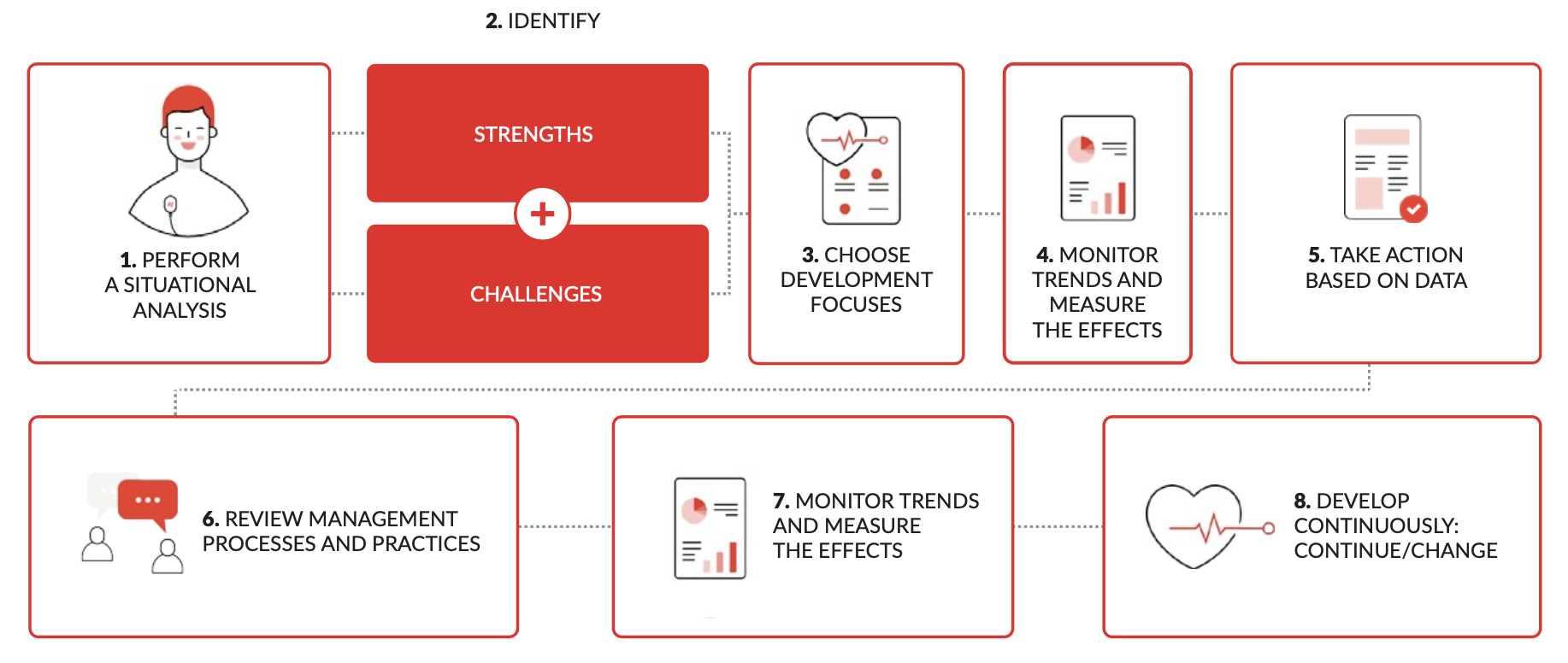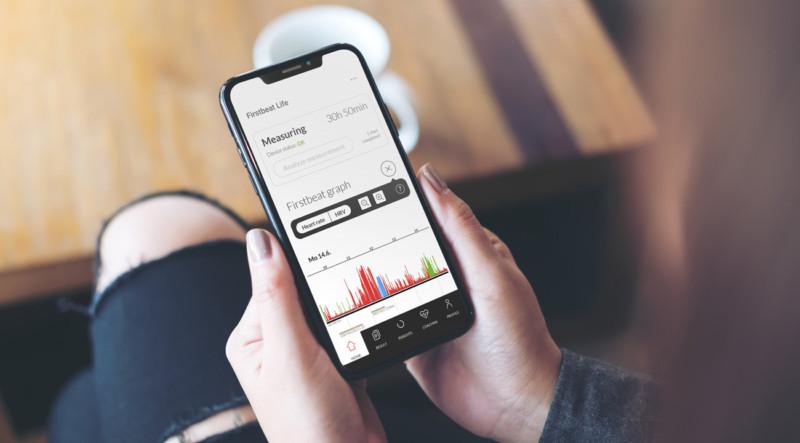
Busy schedules, multitasking, blurring boundaries between work and leisure… To mention a few of the issues many employees are nowadays struggling with. In fact, the struggles of the employees are also the struggles of the employers: an exhausted employee is neither effective nor creative – or they aren’t at work at all. In the long run, exhaustion can even cause sick-leave absence and even work disabilities.
Luckily these workplace challenges are recognized more often. Nowadays, employee well-being is discussed a lot and a lot of effort is put into it. The pioneers have understood that employee well-being is such an important factor that it needs to be managed just like other business sectors – and that can’t be done without an effective well-being strategy, effective goal setting and regular monitoring.
Set Concrete Goals for Employee Well-being
Strategy can be defined as a plan intended to achieve some predefined goals. This also applies to an employee well-being strategy: you need to know what you are aiming for. Needless to say, you can have different types of goals – and in most cases, it’s wise to do so.
Long-term well-being strategy aims usually to happier, healthier and more productive employees. However, on a practical level you need to have more concrete and specific goals, which you are able to monitor regularly.
Naturally, every organization sets its own goals, but here are few examples how you can approach the theme:
- A moderate workload for everyone. How to ensure that some employees are not overwhelmed by the number of tasks.
- A real possibility for rest and recovery. Does both the schedules and the organization culture make it possible to take breaks and detach from work during free time?
- Motivation generates productivity. How can you stimulate and maintain employees’ internal motivation?
The nice thing is that nowadays you don’t need to set goals based on your gut feeling only. Modern well-being tools can offer reliable and holistic data which makes it much easier to build an effective employee well-being strategy.
Data Reveals the Pain Points of Your Employee Well-being
Before you start fixing, you need to know what is broken. In other words: you need to clarify the current state of your employee well-being first – and this is where the data and measurements come in to play.
Nowadays there are lots of different kinds of data available and it’s wise to utilize a combination. For example, by combining occupational health care and HR statistics, objective employee surveys and subjective physiological measurements you will get a complete picture of your company’s status.
Appropriate and reliable data allows you to discover the current pain points and possible risk for your employee well-being – as well as the things that are well on track already.
Once you have chosen the development targets and set your goals, you get into the real actions by means of which you try to reach the goals. For example, you might need to think about the reorganization of work or make some concrete changes into the organization’s culture.

Strategic corporate wellness involves understanding the current situation and applying data-driven management. The identification of good practices and risk factors lays a solid foundation for selecting new development focuses.
Employee Well-being Strategy Becomes Visible via Regular Monitoring
So, you have now created your well-being strategy, set the goals and taken the procedures into action – great! You are on the right path.
Now you must be wondering, ‘what happens next?’ How do you know if you are getting closer to achieving your goals or not? How do you verify the effectiveness of your actions?
Once again, the data is the key. Actually, you could say that your employee well-being strategy becomes visible via regular monitoring: data shows whether you on the right path or not.
It is already a good situation when there are both long-term and short-term goals as well as concrete actions in the employee well-being strategy. But what you still need is regular monitoring. Without that you don’t really know if the actions are any good and if you are going to achieve the goals or not.
Now, the data and measuring comes in to play. Namely, well-being strategy must not be based on the gut feeling of HR or the management – nor on the subjective employee surveys only, no matter how valuable they are. It’s worth utilizing some objective, measured data to support the employee well-being strategy.
So, here are few simplified examples about monitoring the effectiveness of actions:
- Baseline: Firstbeat Life reveals the physical activity level of your employees is low.
- Goal: Increasing the physical activity level
- Action: Offering sport vouchers
- Monitoring: Firstbeat Life shows that physical activity level has increased only for those employees that were physically active in the first place
- New action: Favoring walk and talk meetings
- Monitoring: Firstbeat Life reveals that also the passive employees have increased their physical activity level
—
- Baseline: Firstbeat Life reports show that the recovery of the employees decreases during the busiest time of business
- Goal: Improving the recovery during busy peak times
- Action: Prioritizing the task with the supervisors
- Monitoring: According to Firstbeat Life data, the amount of stress doesn’t really change, which reveals that the prioritizing hasn’t had the desired effect
- New action: Company-level policy that no work messages are allowed outside office hours
- Monitoring: Data shows that sleep quality and recovery increases
Like the simple examples above show, Firstbeat Life takes the employee well-being management to a whole new level. Its company and group reports provide objective, numerical – and naturally anonymous – data about the health and well-being of the employees. Regular reports make it possible to monitor stress, recovery, sleep and physical activity on a company and group level. This, in turn, allows you to identify the possible risks in advance.
With Firstbeat Life, you can move from reactive management to proactive employee well-being management. Instead of trying to find covers for sickness leaves or wondering what has affected a decrease in productivity, you are able to recognize the incipient sleep problems or exhaustion early.
Lastly, it’s good to keep in mind that the path from the starting point to the goal is hardly ever straightforward. The world changes, as does the organization and also the life situations of the employees. With reliable data and regular monitoring, you are able to develop your well-being strategy and the actions accordingly.
Do you want to lead workplace well-being and promote employee health with science-backed insights? You can now find Firstbeat Life plans for companies online. Easily compare different options and find the one that suits you the best.
You might also be interested in

Q&A: How to Improve Employee Well-Being in the Hybrid Working World
Hybrid working isn’t a new concept. The pandemic has, though, put a bigger spotlight on this flexible working model and its inevitable role in the future. Here are some of the questions we were asked during our webinar, ‘How to improve employee well-being in the hybrid working world’.

Employee Well-Being Strategy – What Is It and How Do You Create One?
Nowadays there is a lot of talk about employee well-being, but how often is it at the core of a company’s priorities along with finance and product development? Is employee…

Structure Your Day Better with Firstbeat Life’s Real-Time Results
The newest feature in Firstbeat Life – real-time results – give you a glimpse into your stress and recovery status during the measurement. Real-time data allows you to react promptly and…


